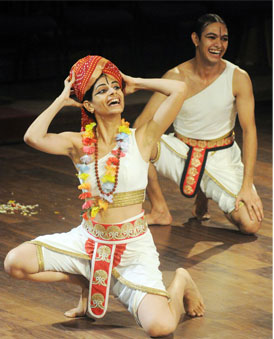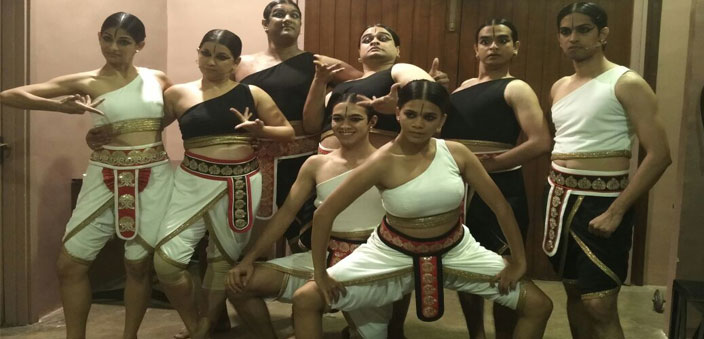There lies Bhishma between Sky and Earth,
his soul rejected from clouds and dirt,
hanging in-between,
a deathly dream,
it was not night nor was it day,
on the ninth day of battle exactly mid-way,
killed by a man nor woman he,
his death set her soul free,
Shikhandi-Amba-Man-Woman rejoiced,
On her chariot so elegantly poised
(Excerpt from ‘Shikhandi’, written and directed by Faezeh Jalali)
Time is intricate in Hindu mythology. The universe passes through many cycles, a basic cycle is called a ‘kalpa’ which is a day in the life of ‘Brahma’. This day is equivalent to about 4320 billion earthly years, Brahma’s night is as long as his day. Within each kalpa are 14 manvantaras (secondary cycles), which contain 71 mahayugas. Every mahayuga in turn consists of four ‘Yugas’, namely Krita, Treta, Dvapara and Kali. It is said that the time we live in is the Kaliyuga, which began in the year 3102 BCE. This same year was also believed to be the year of the Mahabharata. In the entire landscape of time and its complex cycles, the Mahabharata occurs for eighteen days, and within those 18 days ‘Itihasa’ (History) is made. But where does ‘Itihasa’ truly initiate? Did the war of Mahabharata last only 18 days? Or had it begun earlier? Was it a war fought by men or women? Faezeh Jalali attempts to answer these questions through her tongue-in-cheek comedy Shikhandi.
The story of Shikhandi doesn’t start at birth, but begins in a previous life as ‘Amba’. Amba was rejected by the celibate ‘Bhishma’, played by Nikhil Murali, after she proposed to marry him. The humiliated Amba does severe penance to bring down lord Shiva and asks for a boon to kill Bhishma. Shiva accepts Amba’s request but reserves it for her future incarnation. ‘Amba’ is born as ‘Shikhandi’ to Drupada, but meets a Yaksha in the forest and transforms into a man. The Kurukshetra battle field is where Shikhandi meets Bhishma again. But since Bhishma was sworn to never fight a woman in his life, his defeat is inevitable. He was killed by no man or woman, but by Shikhandi who can be identified with neither or both. The death of Bhishma would come when he would decide it, but his defeat on the field was death itself.
Tackling the gender question
The play by writer-director Faezeh Jalali brings forth the gender question and its multifaceted nature. Hegemonic masculinity and its contorted principles are stark and bare in the form of characters like Bhishma. Where does it all start? Is the entire war of Kurukshetra just genders at play? Does Bhishma die because of Shikhandi or is he murdered by his own false ideas of masculinity? Bhishma’s death brings the death of patriarchy with the hands of all the compound patterns of gender into one, Shikhandi.
The set of the play also reveals the many-sided patterns of gender. The floor is laid with intricate designs of ‘kolam’. A kolam is known by various names around India. It is called rangoli in Maharashtra, hase in Kannada, and muggulu in Andhra Pradesh. A kolam is essentially made up of dots, lines and other shapes. These dots and lines are linked to each other making symmetrical designs. But as the numbers of dots increase, the patterns that emerge out of them are different and diverse. No two kolams are alike, and though some might think that these patterns are chaos, they are not. Each kolam has its own beauty and its own identity.
The play’s patterns in gender are as complex as the kolams. One such character which brings forth the gender question is Draupadi, played by Shrishti Shrivastav. She is no gentle damsel, but is full of rebellion, expletives and brute power. All that we embody as maleness takes shape in Draupadi. Her inability to perform the role of her gender is highly evident and its confusion raises poignant questions in Shikhandi’s mind. Drupada, again played by Nikhil Murali, heightens this confusion by drilling down stereotypes as answers to Shikhandi’s confusion. Another character which poses the gender question is the Yaksha ‘Sthuna’. He exchanges his masculinity with Shikhandi for the need to become female. The Yaksha’s audacity lies in the fact that he would challenge all power structures in the need to achieve the pattern of gender he was not born with. In a way, the Yaksha makes his own kolam to achieve a design of gender. Sthuna, played by Vikrant Dhote, will challenge even the Yaksha King (Karan Desai) to become female. The gender transformation is reminiscent of Eddie Redmayne’s performance in The Danish Girl where Einar Magnus Andreas Wegener undergoes the first sex reassignment surgery to transform into Lili Elbe.

The biggest questions are raised by the protagonist ‘Shikhandi’, played by Mahnaz Damania. Her confusion in the simplistically gender divided world makes the struggle visible. Her past of Amba and her future of Shikhandi push and pull her present furiously. The power of Drupada doesn’t help either. He indoctrinates her with the idea that she is a man, which makes another distinct kolam of man-woman. The entire community calls her strange words ‘Goy’, ‘Birl’, ‘Bog’, ‘Girb’, and the predictable ‘Hijra’, ‘Chakka’, and ‘Sixer’, because no one can understand her kolam.
The other highlights
The other interesting roles played are by the narrators of this tale, Tushar Pandey and Meher-Acharia-Dar. They raise many questions about identity and have witty retaliations to contemporary political issues. Their own genders are questionable because does a narrator really have one?
The play is well supported by the experience of Arghya Lahiri’s light design, which brought the realm alive. The NCPA Experimental Theatre stood devoid of stage, and the divide between performer and audience was vanquished, another binary was broken for the in-betweens. There is live music reminiscent of BR Chopra’s ‘Mahabharata’ which provides the necessary tempo to keep the pace but the fundamental unit of this performance are the actors, who encompass the space with their bodies. The energy of the performance is high and it stays up there for the entire length of ninety minutes.
Shikhandi has a palette of its own. The myriad kolams that merge in time are not true only for one generation, one ‘yuga’, one ‘manvantara’ or one ‘kalpa’, but are true for time as such. The patterns bring forth permutations and combinations of humanity, which cannot simply be divided into male and female, right and wrong, good and bad, white and black. There are in-betweens and there are greys. The simplistic divisions of gender roles have been a part of our lives since the onset. But this fresh revisiting of the ‘Mahabharata’ takes us to a time past and showcases an ‘itihasa’ where gender was as fluid as the Ganges.


 [/column]
[/column]